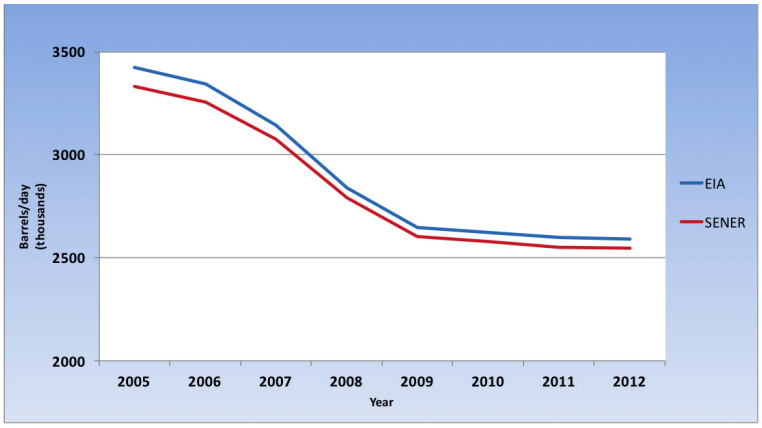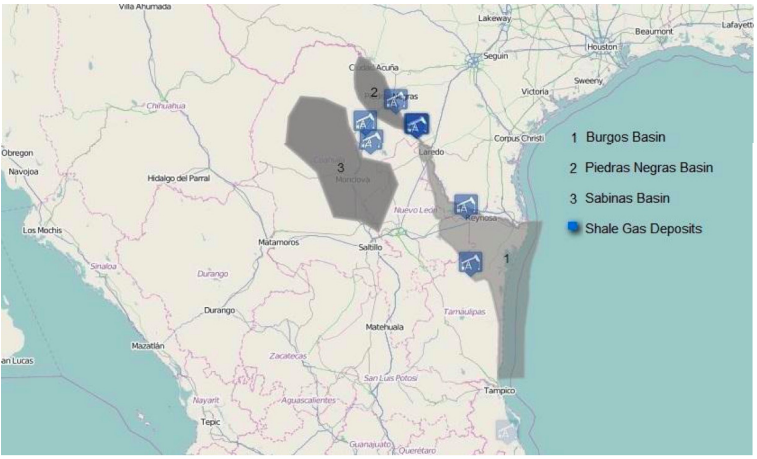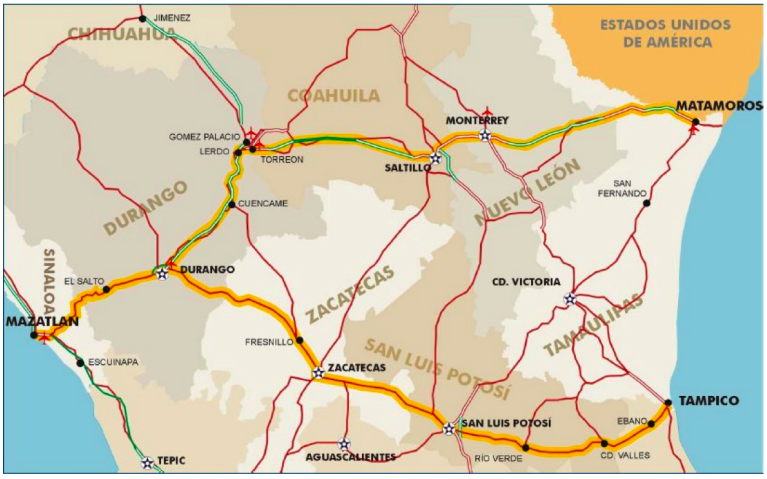Energy Reform and Security in Northeastern Mexico

Table of Contents
Author(s)
Tony Payan
Françoise and Edward Djerejian Fellow for Mexico Studies | Director, Center for the U.S. and MexicoGuadalupe Correa-Cabrera
Former Nonresident FellowShare this Publication
- Download PDF
- Print This Publication
- Cite This Publication Copy Citation
Payan, Tony and Guadalupe CorreaCabrera. 2014. Energy Reform and Security in Northeastern Mexico. Issue Brief no. 05.06.14. Rice University’s Baker Institute, Houston, Texas.
Mexico’s Energy Reform
In December 2013, Mexico’s Congress approved constitutional changes that opened the energy sector to private and foreign investment for the first time since the late 1930s. Enabling legislation is pending but likely to pass in the coming months. A rapid decline in Mexico’s oil production motivated the change: Production at PEMEX, the state-run oil monopoly, has dropped from 3.3 mbpd in 2005 to 2.5 mbpd in 2012, according to Mexico’s Ministry of Energy. The decline poses potential problems because oil revenues make up nearly one-third of the federal budget. The drop could also make Mexico a net importer of energy for the first time since the 1970s. Compounding the issue, Mexico’s aging energy infrastructure has fallen well behind international standards.
Energy reform is promoted as a solution to these problems because it would boost private and foreign investment with a consequent rise in oil, gas, power production, and national income. The government of Mexico (GOM) is also counting on significant foreign investments in energy sector infrastructure. The Mexican public has been promised the structural changes will lead to a more robust economy, lower energy costs, and more—as well as higher paying—jobs.
Looming in the background of this rosy scenario, however, are organized criminal groups that prey on Mexico’s oil industry and control much of the infrastructure of the country’s Northern Economic Corridor (NEC).
Hydrocarbons in Northeastern Mexico
Mexico’s northeast, an area rich in hydrocarbons, includes the Burgos Basin, site of the country’s most important non-associated gas reserve. Encompassing 70,000 sq. mi., the basin spreads through Tamaulipas, Nuevo León, and Coahuila. It is touted as one of the first areas that will open to private and foreign investment for the exploration, extraction, and refinement of hydrocarbons.
Figure 1 — Total Mexican Crude Oil Production, 2005–2012

Mexico’s northeast has also seen other abundant discoveries of oil and gas. In 2012, PEMEX found two new oil reservoirs in the deep waters of the Gulf of Mexico, close to the city of Matamoros, Tamaulipas. “One of the reservoirs would add between 75 and 125 million barrels of crude oil in proven, possible and probable reserves … increasing the potential range of the oil system located in northern Gulf of Mexico by 4,000 to 13,000 million barrels.”1 The federal government and the state of Tamaulipas anticipate important developments for the energy sector in this region, and recently unveiled a $130 million master plan for the integral development of the Port of Matamoros on the Rio Grande delta.2
Figure 2 — Hydrocarbons in Northeastern Mexico

In October 2011, Mexico’s Ministry of Energy announced another major discovery: large shale gas deposits along the U.S.-Mexico border. Then-secretary of energy Jordy Herrera said the fields could “change Mexico’s face in the hydrocarbons sector” and guaranteed they would increase the country’s annual GDP growth by one percentage point. PEMEX Exploration and Production estimated that gas reserves there could be 4 to 5 times more than the 4 billion cubic feet of certified reserves in the Burgos Basin, or approximately 20 billion cubic feet.3
Several transnational companies are already developing part of the potential reserves in the Burgos Basin with PEMEX. The area will likely be the focus of significant Integrated Project Management projects4 after energy reforms are implemented, making Mexico a world leader in natural gas production. Mexico currently ranks fourth in the world in shale gas reserves.5
Oil and shale gas discoveries in northeastern Mexico have increased the importance of the region internationally. Energy reform offers great opportunities for foreign capital in the region, but important security risks must be overcome to achieve desired outcomes. Unfortunately, northeastern Mexico is currently in the grip of one of the country’s most violent criminal groups, Los Zetas—but the Zetas have not deterred the Mexican government from building major infrastructure projects ahead of expected private and foreign investments; the GOM is, in fact, increasing public investment in transportation infrastructure.
Infrastructure Upgrades
The Mazatlán-Matamoros superhighway, officially opened in December 2013, is one of Mexico’s most important new projects in recent years. The states connected by the highway, among the most modern in Latin America, represent 19 million people and 23 percent of Mexico’s GDP. It will significantly advance the international trade of goods and businesses by connecting the markets of the Pacific with those in the United States. What’s more, the highway makes Mazatlán the gateway to Asian markets for energy resources from northeastern Mexico.
Two superhighways run through the Northern Mexico Economic Corridor (NEC), linking it to the Pacific and the Gulf of Mexico and Texas. The highways are considered crucial to “promote economic growth, increase competition, reduce production and distribution costs, create economies of scale, and support the sectors that move energy reserves in and out of the country.”6 The aim of area improvements “is to construct highway, railroad, port, multimodal and telecommunications infrastructure, as well as to develop industrial, technological and logistical parks that allow the strengthening of the region’s economy.”7 For states bordering Texas, this means new business opportunities, the promotion of cross-border trade, and a new generation of investment projects.
In January 2010, the largest and most modern international bridge between Mexico and Texas opened in this area: the four-lane, five kilometer-long Anzaldúas International Bridge. This bridge speeds the transit of people and commercial goods by connecting Reynosa, Tamaulipas, with Mission and McAllen, Texas, where important industrial parks have been established and dozens of maquiladoras and other cross-border business are located.
These projects were built in preparation for energy reform and are crucial for attracting private and foreign investment to the region—but they are a target of Los Zetas on the east of the NEC and the Sinaloa cartel on the west, an obvious challenge for investors in the region.
A New Phase of Organized Crime in Mexico
Mexico’s organized crime groups have diversified in the last decade, moving from drug smuggling to making billions of dollars in illegal mining and iron ore exports, illicit logging, human trafficking and smuggling, kidnapping for ransom, extortion, and pirated goods. “Organized crime has extended its networks to other areas that were unthinkable in the past. It is a business at the end of the day, even though it is illegal.”8 Los Zetas’ territorial control stretches to the Burgos Basin; the group has been involved in the theft of crude oil, gas, and gasoline in a practice known as bunkering—milking pipelines and transportation trucks. These activities have been facilitated by a relationship with corrupt local law enforcement agencies and politicians.9
The impact of organized crime on the energy sector in the NEC is difficult to quantify, but it is a real threat to the intended effects of Mexico’s energy reforms. SENER and PEMEX recognize that the theft and illegal sale of gas condensate as well as the theft of oil and its byproducts are a serious concern in the region.10 There is now a complex criminal network through which millions of liters of oil products are stolen and smuggled north. According to some investigators, criminal groups steal up to 40 percent of natural gas condensate extracted from Mexico’s northern border region and sell it in the U.S. black market.11 In some areas, “crime groups have virtually taken over PEMEX’s pipeline system, stealing growing amounts of fuel and gaining an important source of revenue as they fight other gangs and Mexico's government.”12 Like PEMEX, private companies operating in the region can also become victims of this kind of theft.
Figure 3 — Highways Connecting the Pacific and the Gulf

Los Zetas have also shown they are capable of conducting transnational business.13 PEMEX has filed two lawsuits in U.S. federal court against companies that allegedly purchased stolen gas from Los Zetas through intermediaries. Organized crime groups are also profiting from small mines bordering the U.S. by selling coal for fuel to private businesses.14 Some sources observe that Los Zetas “produce or purchase around 10,000 tons of coal weekly to later sell for 600 pesos ($50) per ton. It is a business generating at least between $22 and $25 million a year.”15 Energy companies venturing into the NEC region would have to be vigilant to prevent unwitting involvement with suspect groups.
In 2010 and 2011, the violence that followed the GOM’s war on organized crime resulted in half of the companies operating in the Burgos Basin to leave the area. The carnage that shattered Mexico’s border towns and cities located near the basin can extend to crews, equipment, and installations, and raise security costs. PEMEX has been unable to stop its workforce from cooperating with Los Zetas, usually through coercion. This demonstrates a lack of adequate surveillance and possible involvement with public officials. Although the GOM has made some progress against Los Zetas, the group remains strong and can still threaten, steal, extort, kidnap for ransom, and even terrorize the industry’s personnel. Transnational companies doing business in the NEC area are at risk of having to deal with organized crime, given that the GOM has been unable to fully neutralize the fierce and highly organized Zetas.
Public Policy Implications
The GOM’s failure to establish complete control of the NEC region is a problem in and of itself—but the failure to recover vast swaths of territory lost to Los Zetas and bring it into full government control under the rule of law puts the reform initiative’s promises at risk. The GOM must strengthen all of its justice institutions and reestablish law enforcement credibility to provide not only legal certainty but also assurances to private and foreign investors that their capital is protected. The government must also be transparent about the dimensions of criminal activity in the region and work with investors to address the problem. The main areas of focus should be police reform and the fight against corruption. The current alternatives—ignoring the problem of organized crime, concealing crime statistics, keeping armed forces in the region to provide public safety, asking companies to invest in private security for themselves, and even petitioning foreign law enforcement agencies to help—compromise the GOM’s credibility, jeopardize the reform’s goals, and place companies operating in Mexico at the same risk level as those conducting business in Libya or Nigeria.
Endnotes
1. Edgar Sigler, “Pemex encuentra nuevo yacimiento,” CNN Expansión, October 5, 2012.
2. COLEF Newsletter, “Bajo Bravo-Río Grande Valley,” February 10, 2014.
3. Noé Cruz, “Descubren yacimiento que quintuplica reservas de gas,” El Universal, October 25, 2011.
4. Nayelli García Esparza Tapia, “Construcción de pozos y desarrollo de campos petroleros en Mexico,” Oilfield Review, 2004.
5. Cruz, “Descubren yacimiento,” 2011.
6. Sinaloa Government, “Mazatlán: ‘Puerta del Corredor Económico del Norte,” May 2011.
7. Juan José García, “Quiere Chihuahua integrarse a Corredor Económico del Norte,” Manzanillo Xport, May 19, 2012.
8. Mónica Cruz, “El narco abastece a Estados Unidos de su otra droga,” Emeequis, September 19, 2011.
9. T. Payan, K. Staudt, and Z. A. Kruszewski, A War That Can’t Be Won: Binational Perspectives on the War on Drugs (Tucson, AZ: University of Arizona Press, 2014).
10. Secretaría de Energía, Estrategia Nacional de Energía, 2013-2027.
11. Ana Lilia Perez, How organized crime owns Pemex (Grijalbo Mondadori Sa, 2011).
12. Anthony Harrup and David Luhnow, “Mexican Crime Gangs Expand Fuel Thefts,” Wall Street Journal, June 18, 2011.
13. The Knights Templar, successors of La Familia in Michoacana, is another such group.
14. Agence France-Presse, “El carbón, nuevo lucrativo negocio para el cartel mexicano de Los Zetas,” November 16, 2012.
15. Ibid.
This material may be quoted or reproduced without prior permission, provided appropriate credit is given to the author and Rice University’s Baker Institute for Public Policy. The views expressed herein are those of the individual author(s), and do not necessarily represent the views of Rice University’s Baker Institute for Public Policy.


